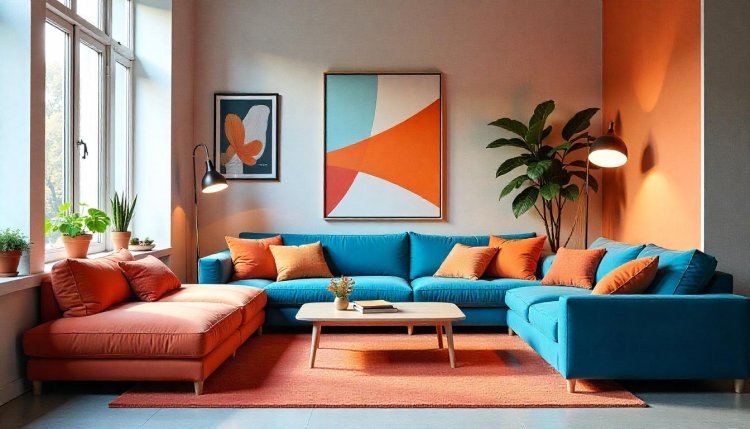What Is Color in Interior Design? Importance and Role
Learn what color in interior design is and how it affects mood, functionality, and space perception. Discover tips and strategies for effective color use.

What is color in interior design? Color is a fundamental aspect of interior design that directly affects the ambiance, mood, and functionality of a space. By strategically incorporating color, designers can enhance the aesthetics and purpose of interiors while influencing how people feel and interact within the environment.
Understanding the Role of Color in Interior Design
Color is more than just a decorative element—it is a powerful design tool that shapes perceptions and defines the atmosphere of a room. Designers use color to highlight architectural features, create focal points, and establish visual harmony.
The psychology of color plays a significant role in interior design. Different colors evoke different emotions and behaviors. For instance, warm colors like red and orange create energy and excitement, while cool tones like blue and green promote calmness and relaxation.
The Importance of Color in Interior Design
1. Sets the Mood
- Color determines the emotional response of occupants.
- Bright, vibrant colors evoke energy, while softer tones promote serenity.
2. Defines the Space
- Designers use color to distinguish areas within open-plan spaces.
- Contrast between wall colors and furnishings can help define functional zones.
3. Affects Perception of Space
- Light colors make spaces appear larger and more open.
- Dark colors create a sense of coziness and intimacy.
4. Enhances Lighting
- Light-colored walls reflect natural and artificial light, brightening spaces.
- Dark shades absorb light, creating a dramatic effect.
5. Influences Behavior and Productivity
- Certain colors, such as blue and green, enhance concentration and productivity.
- For example, a Corporate Office Interior Design Firm in Bangladesh may use these colors to optimize work environments.
The Psychology of Color in Interior Design
Understanding the psychological impact of color is essential to creating effective and aesthetically pleasing interiors.
1. Warm Colors
- Red: Stimulates energy and passion but can be overwhelming in large amounts.
- Orange: Encourages enthusiasm and creativity.
- Yellow: Represents happiness and optimism but should be used carefully to avoid overstimulation.
2. Cool Colors
- Blue: Promotes calm, trust, and productivity.
- Green: Associated with nature, relaxation, and balance.
- Purple: Suggests luxury and creativity.
3. Neutral Colors
- White: Creates a clean, spacious feel.
- Gray: Adds sophistication and versatility.
- Beige: Offers warmth and neutrality.
Color Schemes in Interior Design
To achieve harmony and balance, designers use various color schemes:
1. Monochromatic Color Scheme
- Involves different shades and tones of the same color.
- Creates a cohesive and elegant look.
2. Analogous Color Scheme
- Uses colors that are adjacent to each other on the color wheel.
- Provides a harmonious and serene feel.
3. Complementary Color Scheme
- Combines colors opposite each other on the color wheel, such as blue and orange.
- Adds vibrancy and contrast to a room.
4. Triadic Color Scheme
- Involves three equally spaced colors on the color wheel.
- Offers bold and dynamic interiors.
Practical Tips for Using Color in Interior Design
1. Consider Lighting Conditions
- Assess natural and artificial lighting before selecting colors.
- Colors may appear different in varying lighting conditions.
2. Use Accent Colors Wisely
- Limit accent colors to create a focal point without overwhelming the space.
- Incorporate accent colors through artwork, cushions, or rugs.
3. Balance Bold Colors with Neutrals
- Pair bold hues with neutral tones to prevent visual fatigue.
- For example, vibrant furniture can be offset by neutral walls.
4. Test Colors Before Committing
- Use sample swatches or paint small areas before making a final decision.
Common Mistakes to Avoid
1. Overusing Bright Colors
- Too many bright colors can create a chaotic atmosphere.
- Balance them with neutral tones for a harmonious look.
2. Ignoring the Room’s Function
- Choose colors that complement the room’s purpose.
- For example, calming colors are ideal for bedrooms, while vibrant hues work well in living rooms.
3. Neglecting Cohesion
- Ensure that color choices throughout the home maintain visual continuity.
- Avoid abrupt transitions between rooms.
Case Study: The Impact of Color in Office Spaces
Color plays a vital role in workplace productivity and morale. In corporate offices, designers often use shades of blue and green to enhance focus and reduce stress. Collaborating with a Corporate Office Interior Design Firm in Bangladesh ensures that businesses can implement effective color strategies tailored to their specific needs.
Conclusion
Color in interior design is a powerful tool that impacts mood, behavior, and spatial perception. By understanding its importance and strategic application, designers can create spaces that are functional, visually appealing, and emotionally engaging. Whether you’re designing a home or a commercial space, thoughtful color choices can transform interiors into welcoming and inspiring environments. For expert guidance in optimizing spaces through color, consider consulting a Corporate Office Interior Design Firm in Bangladesh.
What's Your Reaction?













